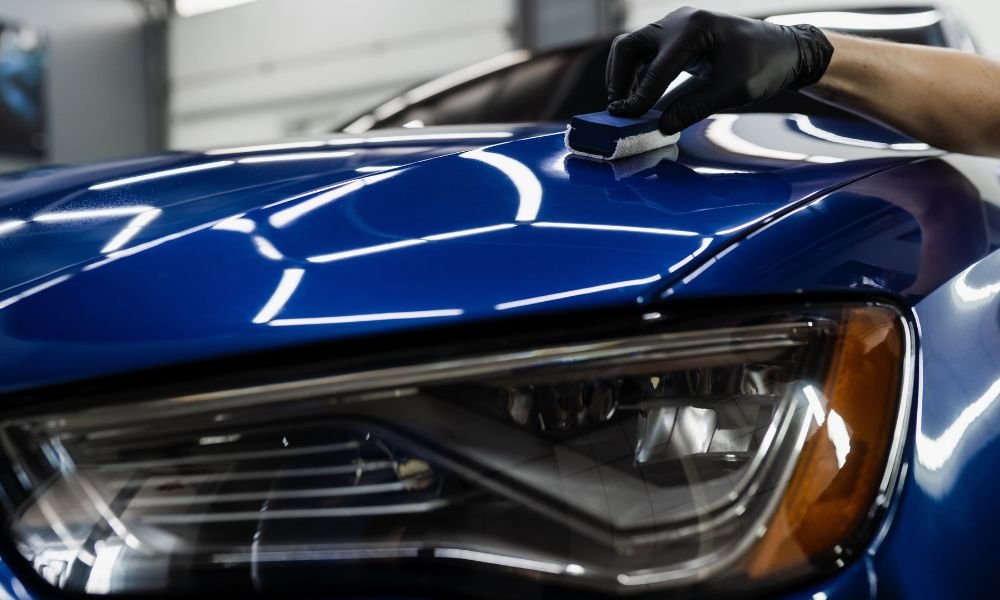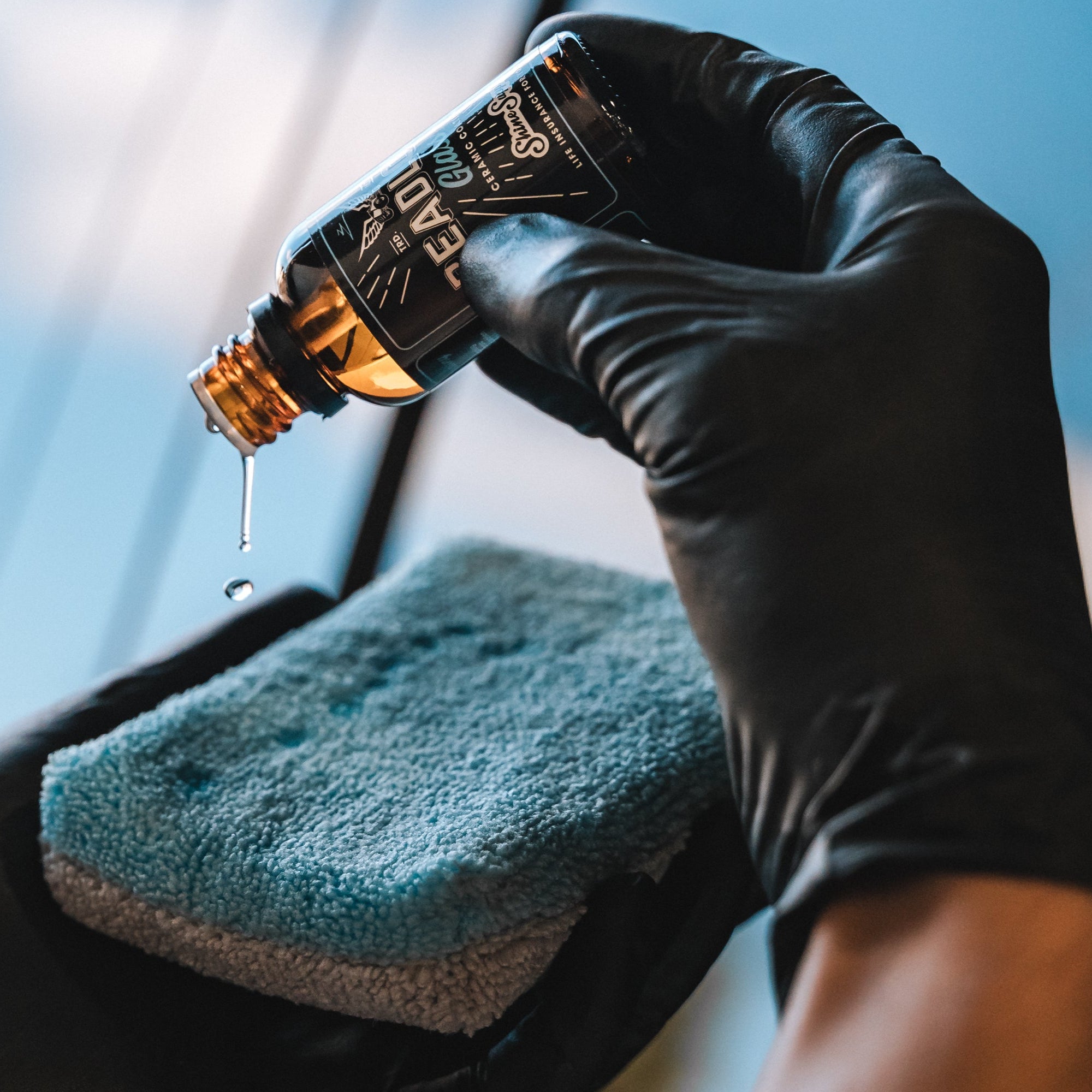Discovering the Scientific Research Behind Car Ceramic Coating and Its Protective Qualities
The scientific research of car ceramic coating presents an interesting research in innovative automotive defense. Composed mostly of silicon dioxide and polymers, these finishes create a durable bond with car paint. This communication improves sturdiness versus ecological dangers while supplying hydrophobic advantages. The complexities of exactly how these coverings job and their long-lasting advantages remain less understood. Ceramic Coating Newark. Unboxing these information discloses why ceramic finishes are becoming a recommended choice for lorry treatment
What Is Ceramic Coating?
Ceramic coating is a liquid polymer that chemically bonds to the surface of an automobile's paint. This sophisticated protective layer boosts sturdiness and uses exceptional resistance to ecological aspects. Unlike typical wax or sealers, which offer short-lived security, ceramic coatings create a durable guard that can stand up to severe conditions such as UV rays, acidic impurities, and extreme climate. When applied properly, the coating creates a hydrophobic surface area, causing water to grain and slide off, which helps in preserving the car's cleanliness. In addition, it uses improved gloss and deepness to the paint, making the lorry show up even more polished and lively. The application process usually involves comprehensive surface preparation, consisting of cleansing and polishing, to ensure peak bonding. Consequently, ceramic coatings are coming to be progressively prominent among car fanatics and those seeking to shield their investments, promising to keep the lorry's visual charm while minimizing the frequency of maintenance.
The Make-up of Ceramic Coatings
The complex formulation of ceramic layers largely is composed of silicon dioxide (SiO2), which is obtained from natural resources like quartz and sand. This key part gives the foundation for the coating's longevity and safety high qualities. Along with SiO2, ceramic coatings typically consist of various polymers and additives that improve bond, versatility, and resistance to environmental elements. These substances work synergistically to produce a durable obstacle versus impurities such as dust, chemicals, and UV rays.Furthermore, some solutions incorporate titanium dioxide (TiO2) or other nanomaterials, which can boost the coating's hydrophobic residential properties, leading to enhanced water repellency. The exact structure can differ significantly among producers, affecting efficiency and longevity. Ultimately, the combination of these components finishes in a safety layer that not just boosts the aesthetic charm of lorries yet also offers to lengthen their lifespan by securing the surface from possible damages.
How Ceramic Coatings Job
Understanding just how ceramic layers function includes exploring their chemical make-up, which contributes to their safety qualities. The application procedure is important for attaining ideal outcomes, while durability and longevity variables determine the coating's effectiveness in time. Together, these aspects highlight the advantages and efficiency of ceramic coatings for vehicle defense.
Chemical Composition Explained
While several car proprietors seek lasting protection for their vehicles, the chemical make-up of ceramic coverings plays an important function in their efficiency. These coverings mainly include silicon dioxide (SiO2), which is originated from natural minerals. This substance forms a strong bond with the automobile's paint, developing a sturdy, protective layer. Furthermore, several ceramic finishes have titanium dioxide (TiO2), enhancing their hydrophobic residential properties and resistance to UV rays. The existence of polysiloxanes can better boost adaptability and durability. With each other, these elements add to the coating's ability to repel water, dust, and contaminants, while likewise supplying a high-gloss coating. Recognizing this chemical structure aids car owners appreciate the robust defense used by ceramic coatings.
Application Refine Overview
Applying ceramic coverings includes a meticulous procedure that ensures perfect bonding and protection for the car's surface. Originally, complete cleansing and purification of the car's outside are executed to eliminate dirt, crud, and previous waxes. This action validates that the surface area is without pollutants that could hinder attachment. Following this, the paint is usually brightened to improve clearness and remove any blemishes. Once prepared, the ceramic coating is applied in little sections utilizing an applicator pad, permitting uniform protection. The coating is after that entrusted see to heal, creating a solid chemical bond with the surface area. Proper curing times and conditions are important, as they verify the coating attains its maximum performance and protective top qualities.
Longevity and Resilience Variables
Ceramic coverings are made to provide lasting security through their innovative chemical composition, which develops a robust barrier versus ecological impurities. The durability of these finishes is affected by variables such as the density of the application, the top quality of the item, and the problems under which the car is exposed. High-quality ceramic finishings can last several years, standing up to scrapes, UV rays, and chemical stains. Appropriate upkeep, consisting of regular washing and regular reapplication, can even more enhance longevity. Additionally, environmental variables like climate and direct exposure to toxins can impact the lifespan of the coating. On the whole, when used and kept correctly, ceramic layers provide phenomenal sturdiness, making them a popular option for car lovers seeking to protect their lorry's look.
Hydrophobic Qualities and Water Repellency
Hydrophobic residential or commercial properties are a trademark of top quality car ceramic finishes, considerably boosting the car's surface efficiency. These coatings create a molecular bond with the car's paint, resulting in a surface area that pushes back water effectively. When water enters call with a ceramic-coated surface area, it grains up and rolls off, lessening the amount of liquid that stays on the paint. This actions not just adds to a visually pleasing appearance but likewise decreases the accumulation of pollutants such as dust, gunk, and roadway salts.The improved water repellency leads to simpler cleansing and upkeep, as much less effort is called for to remove unwanted compounds. Additionally, the hydrophobic nature of ceramic layers helps in protecting against water places, which can mar the coating of uncoated surface areas. In general, the consolidation of hydrophobic homes in ceramic finishings plays a necessary role in preserving the automobile's pristine look while streamlining maintenance.
Protection Against Scratches and UV Damage
Car ceramic finishings offer substantial defense against scrapes and UV damages. The scrape resistance mechanism produces a long lasting layer that takes in impacts, while the UV shielding advantages help maintain the vehicle's paint honesty in time. With each i loved this other, these attributes add to a longer-lasting and visually enticing surface.
Scratch Resistance System
Utilizing advanced technology, ceramic layers provide a durable shield against scratches and UV damages, improving the longevity and look of vehicle surface areas. The scrape resistance device of these coatings is credited to their one-of-a-kind molecular structure, which forms a resilient bond with the lorry's paint. This bond develops a hard, protective layer that can absorb influences and withstand abrasions. In addition, the smooth surface of the coating minimizes rubbing, making it difficult for pollutants to adhere and cause scrapes. The chemical structure of ceramic finishes frequently includes nanoparticles that enhance the protective layer, further enhancing its durability. As a result, vehicles treated with ceramic layers show substantially boosted scrape resistance compared to typical wax or sealers, making certain a pristine coating in time.
UV Protecting Advantages
The protective high qualities of ceramic layers extend beyond scrape resistance to consist of significant UV shielding advantages. These finishings create a durable barrier that shows dangerous ultraviolet rays, securing the lorry's paint and underlying materials. Prolonged exposure to UV radiation can cause fading, oxidation, and deterioration of the paint surface. By including ceramic finishings, vehicle proprietors can efficiently minimize these dangers, preserving the aesthetic appeal and stability of their vehicles. In addition, the UV blocking homes add to improved durability, decreasing the regularity of repainting and maintenance. Inevitably, the assimilation of ceramic layers uses a complete option for protecting automobiles from the destructive results of sun exposure, making sure a continual, dynamic appearance with time.
The Longevity and Upkeep of Ceramic Coatings

Frequently Asked Inquiries
Can Ceramic Coating Be Applied to Any Type Of Kind Of Car?
Ceramic coating can be related to numerous types of automobiles, consisting of autos, trucks, and bikes. Surface area prep work and compatibility with certain materials are crucial for suitable attachment and effectiveness of the coating.
Exactly How Much Does Ceramic Coating Generally Expense?
Ceramic coating normally sets you back in between $500 and $2,000, depending on factors such as vehicle dimension, coating quality, and specialist application. The financial investment can offer lasting security and enhance the vehicle's look in time.

Is Expert Application Essential for Ideal Outcomes?
The necessity of expert application commonly depends on desired outcomes. Professionals commonly assure appropriate surface area prep work and application strategies, resulting in excellent bonding and longevity of the coating, which may be testing for inexperienced individuals to attain.
Can Ceramic Coatings Be Gotten Rid Of or Repaired?
Ceramic coverings can be gotten rid of or repaired, though the procedure might need particular solvents or techniques - Ceramic Coating Newark. Appropriate elimination is crucial to prevent damages to the underlying surface area, stressing the value of specialist aid for excellent outcomes
Exactly How Does Ceramic Coating Compare to Traditional Wax?
The contrast her comment is here between ceramic coating and conventional wax discloses that ceramic coverings provide premium resilience, boosted protection against environmental pollutants, and longer-lasting sparkle, while wax needs extra frequent application and offers less total resistance to damage.